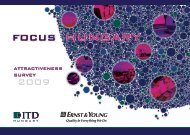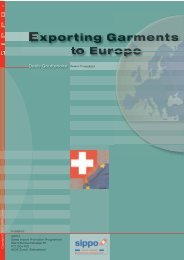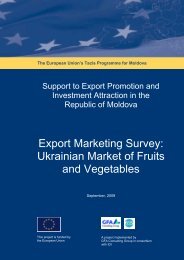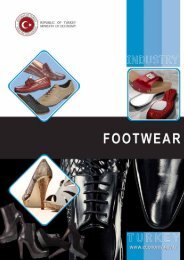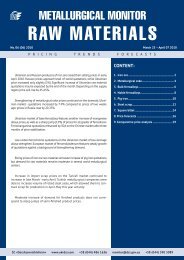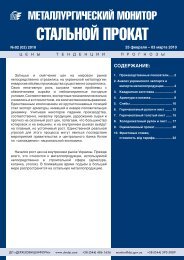Export Marketing Survey: German Market for Textile and Clothing
Export Marketing Survey: German Market for Textile and Clothing
Export Marketing Survey: German Market for Textile and Clothing
Create successful ePaper yourself
Turn your PDF publications into a flip-book with our unique Google optimized e-Paper software.
This Project is financed<br />
by the European Union<br />
Support to <strong>Export</strong> Promotion<br />
<strong>and</strong> Investment Attraction in<br />
the Republic of Moldova<br />
EuropeAid/126810/C/SER/MD<br />
This Project is implemented by a<br />
Consortium led by GFA<br />
Consulting Group<br />
Importing<br />
Manufacturers<br />
Agents<br />
(sales<br />
representatives)<br />
Importing<br />
Retailers<br />
rein<strong>for</strong>cing the wholesalers’ position<br />
• Have their own designers, apply various production <strong>and</strong> procurement<br />
strategies (see chapter on production)<br />
• Penetrate the retail business by opening own shops (vertical integration)<br />
• An independent intermediary between manufacturer <strong>and</strong> retail<br />
• In general the agent receives a commission from the manufacturer<br />
• More <strong>and</strong> more agents sell from stock, to meet short‐term dem<strong>and</strong>s. Stock<br />
<strong>for</strong>ming occurs on consignment basis<br />
• Agents mainly work with br<strong>and</strong>s<br />
Differing from the sales agent is the buying agent. The buying agent is<br />
located in supplying countries <strong>and</strong> acts on instructions of his client, mainly<br />
retail organisations<br />
• Bigger retail organizations import via their own buying / sourcing<br />
departments, <strong>and</strong> thus cut out intermediaries<br />
• They purchase finished products via direct imports (sourcing ready‐made<br />
products) from low‐wage countries <strong>and</strong> sourcing products made according<br />
to their own design (backward integration)<br />
There is the general trend of integration in the value chain, which means:<br />
• Forward Integration: more <strong>and</strong> more manufactures open their own br<strong>and</strong><br />
stores (mono‐label) in order to control the point of sale (higher margins,<br />
better knowledge of consumer dem<strong>and</strong>)<br />
• Backward Integration: retailers set‐up their own design departments <strong>and</strong><br />
source supply with own buying departments or agents<br />
4.2 Retail Structure <strong>and</strong> Trends<br />
The following diagram illustrates the development of the market share of the<br />
different actors in the <strong>German</strong> apparel retail:<br />
100%<br />
90%<br />
80%<br />
70%<br />
60%<br />
50%<br />
40%<br />
30%<br />
20%<br />
10%<br />
0%<br />
12%<br />
18% 19%<br />
39%<br />
34% 32%<br />
15% 14% 14%<br />
10% 9% 9%<br />
18% 16% 16%<br />
6% 9% 10%<br />
1999 2003 2005<br />
<strong>Textile</strong> discounters & non<br />
specialists<br />
Independent retailers<br />
Department stores<br />
Home shopping<br />
<strong>Clothing</strong> mutiples<br />
Verticals<br />
Remarkable is the growth of textile discounters <strong>and</strong> the non‐specialists<br />
(hypermarkets with strong non‐food component) as well as the rise of verticals<br />
(mono‐label stores). Also globally operating apparel retail chains like H&M or Zara<br />
have enlarged their market share. In turn the <strong>for</strong>merly strong independent<br />
10







